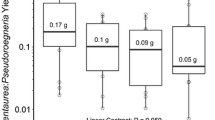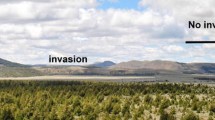Abstract
High species diversity often enhances ecosystem function; however, the effects of diversity have not been commonly explored in the context of natural ecosystem variation. In intermountain grassland, it has been reported that Pinus ponderosa canopies and litter reduces the diversity of native species and increases the abundance of Bromus tectorum, an invasive species. Thus this is a realistic system for exploring context-dependency in the effects of diversity on ecosystem function. We established native plant assemblages that varied in species richness and crossed each species richness level with Pinus litter addition. All plots were experimentally invaded with B. tectorum, allowing us to explore context-dependency in the effects of native diversity on community productivity and resistance to exotic invasion. Native polycultures had higher native plant cover, a surrogate for productivity, and stronger resistance to Bromus invasion relative to monocultures. We found that species-independent complementarity effect was the main contributor to the diversity effect on native plant cover, which increased as species richness in polycultures increased. Species-dependent complementarity/selection effects on native cover were negligible, and neither complementarity nor selection effects on native resistance to invasion varied with native richness. Pinus litter had no direct effect on native cover or Bromus performance, but decreased the effects of high native diversity on native cover and increased the effects of high native diversity on native resistance to Bromus. Thus we found some evidence for context-dependency and that low species richness under Pinus canopies might facilitate Bromus invasion. Importantly, the diversity-dependent increase in native plant cover was not correlated with diversity-dependent increases in resistance to invasion among plots, suggesting different mechanisms for how diversity enhances productivity versus resistance.


Similar content being viewed by others
References
Armas C, Ordiales R, Pugnaire FI (2004) Measuring plant interactions: a new comparative index. Ecology 85:2682–2686
Aschehoug ET, Callaway RM (2015) Diversity increases indirect interactions, attenuates the intensity of competition, and promotes coexistence. Am Nat 186:452–459
Avolio ML, Koerner SE, La Pierre KJ, Wilcox KR, Wilson GWT, Smith MD, Collins SL (2014) Changes in plant community composition, not diversity, during a decade of nitrogen and phosphorus additions drive above-ground productivity in a tallgrass prairie. J Ecol 102:1649–1660
Belote RT, Jones RH (2009) Tree leaf litter composition and nonnative earthworms influence plant invasion in experimental forest floor mesocosms. Biol Invasions 11:1045–1052
Berendse F (1998) Effects of dominant plant species on soils during succession in nutrient-poor ecosystems. Biogeochemistry 42:73–88
Besaw LM, Thelen GC, Sutherland S, Metlen K, Callaway RM (2011) Disturbance, resource pulses and invasion: short-term shifts in competitive effects, not growth responses, favour exotic annuals. J Appl Ecol 48:998–1006
Byun C, de Blois S, Brisson J (2013) Plant functional group identity and diversity determine biotic resistance to invasion by an exotic grass. J Ecol 101:128–139
Callaway RM, Nadkarni NM, Mahall BE (1991) Facilitation and interference of Quercus douglasii on understory productivity in central California. Ecology 72:1484–1499
Connell JH, Slatyer RO (1977) Mechanisms of succession in natural communities and their role in community stability and organization. Am Nat 111:1119–1144
Cowles JM, Wragg PD, Wright AJ, Powers JS, Tilman D (2016) Shifting grassland plant community structure drives positive interactive effects of warming and diversity on aboveground net primary productivity. Global Change Biol 22:741–749
Crawley MJ, Brown SL, Heard MS, Edwards GR (1999) Invasion-resistance in experimental grassland communities: species richness or species identity? Ecol Lett 2:140–148
Cuesta B, Villar-Salvador P, Puértolas J, Benayas JMR, Michalet R (2010) Facilitation of Quercus ilex in mediterranean shrubland is explained by both direct and indirect interactions mediated by herbs. J Ecol 98:687–696
Eisenhauer N, Dobies T, Cesarz S, Hobbie SE, Meyer RJ, Worm K, Reich PB (2013) Plant diversity effects on soil food webs are stronger than those of elevated CO2 and N deposition in a long-term grassland experiment. Proc Acad Natl Sci USA 110:6889–6894
Facelli JM (1994) Multiple indirect effects of plant litter affect the establishment of woody seedlings in old fields. Ecology 75:1727–1735
Facelli JM, Pickett TA (1991) Plant litter: its dynamics and effects on plant community structure. Bot Rev 57:1–32
Fargione J, Brown CS, Tilman D (2003) Community assembly and invasion: an experimental test of neutral versus niche processes. Proc Natl Acad Sci USA 100:8916–8920
Foster BL, Gross KL (1998) Species richness in a successional grassland: effects of nitrogen enrichment and plant litter. Ecology 79:2593–2602
Fox JW (2005) Interpreting the ‘selection effect’ of biodiversity on ecosystem function. Ecol Lett 8:846–856
Grime JP (1977) Evidence for the existence of three primary strategies in plants and its relevance to ecological and evolutionary theory. Am Nat 111:1169–1194
Gundale MJ, Sutherland S, DeLuca TH (2008) Fire, native species, and soil resource interactions influence the spatio-temporal invasion pattern of Bromus tectorum. Ecography 31:201–210
Hector A, Schmid B, Beierkuhnlein C, Caldeira MC, Diemer M, Dimitrakopoulos PG, Finn LA, Freitas H, Giller PS, Good J, Harris R, Högberg P, Huss-Danell K, Joshi J, Jumpponen A, Körner C, Leadley PW, Loreau M, Minns A, Mulder CPH, O’Donovan G, Otway SJ, Pereira JS, Prinz A, Read DJ, Scherer-Lorenzen M, Schulze ED, Siamantziouras ASD, Spehn EM, Terry AC, Troumbis AY, Woodward FI, Yachi S, Lawton JH (1999) Plant diversity and productivity experiments in European grasslands. Science 286:1123–1127
Hooper DU, Vitousek PM (1998) Effects of plant composition and diversity on nutrient cycling. Ecol Monogr 68:121–149
Huston MA (1997) Hidden treatments in ecological experiments: re-evaluating the ecosystem function of biodiversity. Oecologia 110:449–460
James JJ, Davies KW, Sheley RL, Aanderud ZT (2008) Linking nitrogen partitioning and species abundance to invasion resistance in the Great Basin. Oecologia 156:637–648
Jucker T, Bouriaud O, Avacaritei D, Danila I, Duduman G, Valladares F, Cooms DA (2014) Competition for light and water play contrasting roles in driving diversity–productivity relationships in Iberian forests. J Ecol 102:1202–1213
Kardol P, Bezemer TM, van der Putten WH (2006) Temporal variation in plant–soil feedback controls succession. Ecol Lett 9:1080–1088
Knight KS, Oleksyn J, Jagodzinski AM, Reich PB, Kasprowicz M (2008) Overstorey tree species regulate colonization by native and exotic plants: a source of positive relationships between understorey diversity and invasibility. Divers Distrib 14:666–675
Kulmatiski A, Beard KH, Heavilin J (2012) Plant–soil feedbacks provide an additional explanation for diversity–productivity relationships. Proc R Soc B Biol Sci 279:3020–3026
Lasky JR, Uriate M, Boukili VK, Erickson DL, Kress WJ, Chazdon RL (2014) The relationship between tree biodiversity and biomass dynamics changes with tropical forest succession. Ecol Lett 17:1158–1167
Latz E, Eisenhauer N, Rall BC, Allan E, Roscher C, Scheu S, Jousset A (2012) Plants diversity improves protection against soil-borne pathogens by fostering antagonistic bacterial communities. J Ecol 3:597–604
Liao H, Luo W, Peng S, Callaway RM (2015) Plant diversity, soil biota and resistance to exotic invasion. Divers Distrib 21:826–835
Lodhi MAK (1976) Role of allelopathy as expressed by dominating trees in a lowland forest in controlling the productivity and pattern of herbaceous growth. Am J Bot 63:1–8
Loreau M, Hector A (2001) Partitioning selection and complementarity in biodiversity experiments. Nature 412:72–76
Maron JL, Connors PG (1996) A native nitrogen-fixing shrub facilitaes weed invasion. Oecologia 105:302–312
Maron JL, Marler M (2007) Native plant diversity resists invasion at both low and high resource levels. Ecology 88:2651–2661
Maron JL, Marler M (2008) Effects of native species diversity and resource additions on invader impact. Am Nat 172:18–33
Maron JL, Marler M, Klironomos JN, Cleveland CC (2011) Soil fungal pathogens and the relationship between plant diversity and productivity. Ecol Lett 14:36–41
Metlen KL (2010) Using patchy plant invasions to understand how diffuse interactions modify facilitation and competition. Ph.D. thesis, The University of Montana, USA
Metlen K, Callaway RM (2015) Native North American pine attenuates the competitive effects of a European invader on native grasses. Biol Invasions 17:1227–1237
Metlen KL, Aschehoug ET, Callaway RM (2012) Competitive outcomes between two exotic invaders are modified by direct and indirect effects of a native conifer. Oikos 122:632–640
Naeem S, Knops JMH, Tilman D, Howe KM, Kennedy T, Gale S (2000) Plant diversity increases resistance to invasion in the absence of covarying extrinsic factors. Oikos 91:97–108
Naumburg E, DeWald LE (1999) Relationships between Pinus ponderosa forest structure, light characteristics and understory graminoid species presence and abundance. Forest Ecol Manag 124:205–215
Pokorny ML, Sheley RL, Zabinski CA, Engel RE, Svejcar TJ, Borkowski JJ (2005) Plant functional group diversity as a mechanism for invasion resistance. Restor Ecol 13:448–459
Reynolds HL, Packer A, Bever JD, Clay K (2003) Grassroots ecology: plant–microbe–soil interactions as drivers of plant community structure and dynamics. Ecology 84:2281–2291
Riegel GM, Miller RF, Krueger WC (1992) Competition for resources between understory vegetation and overstory Pinus ponderosa in northeastern Oregon. Ecol Appl 2:71–85
Schnitzer SA, Klironomos JN, Hillerislambers J, Kinkel LL, Reich PB, Xiao K, Rillig MC, Sikes BA, Callaway RM, Mangan SA, van Nes EH, Scheffer M (2011) Soil microbes drive the classic plant diversity–productivity pattern. Ecology 92:296–303
Schramm JW, Ehrenfeld JG (2010) Leaf litter and understory canopy shade limit the establishment, growth and reproduction of Microstegium vimineum. Biol Invasions 12:3195–3204
Schwinning S, Weiner J (1998) Mechanisms determining the degree of size asymmetry in competition among plants. Oecologia 113:447–455
Siemann E, Rogers WE (2003) Changes in light and nitrogen availability under pioneer trees may indirectly facilitate tree invasions of grasslands. J Ecol 91:923–931
Tilman D (1997) Community invasibility, recruitment limitation, and grassland biodiversity. Ecology 78:81–92
Tilman D, Reich PB, Knops J, Wedin D, Mielke T, Lehman C (2001) Diversity and productivity in a long-term grassland experiment. Science 294:843–845
Tseng M, Kuo Y, Chen Y, Chou C (2003) Allelopathic potential of Macaranga tanarius (L.) Muell.-Arg. J Chem Ecol 29:1269–1286
Vasquez E, Sheley R, Svejcar T (2008) Nitrogen enhances the competitive ability of cheatgrass (Bromus tectorum) relative to native grasses. Invasive Plant Sci Manag 1:287–295
Wang C, Long R, Wang Q, Liu W, Jing Z, Zhang L (2010) Fertilization and litter effects on the functional group biomass, species diversity of plants, microbial biomass, and enzyme activity of two alpine meadow communities. Plant Soil 331:377–389
Wright A, Schnitzer SA, Dickie IA, Gunderson AR, Pinter GA, Mangan SA, Reich PB (2012) Complex facilitation and competition in a temperate grassland: loss of plant diversity and elevated CO2 have divergent and opposite effects on oak establishment. Oecologia 171:449–458
Zak DR, Holmes WE, White DC, Peacock AD, Tilman D (2003) Plant diversity, soil microbial communities, and ecosystem function: are there any links? Ecology 84:2042–2050
Acknowledgments
We thank Judit Nyulasi, Priscila Silvera, Kimberly Ledger, Kevin Moore, Shengpeng Zuo and Hongli Li for help with our field experiment. We thank Rebecca Fletcher and David Hooper for their help on setting up the auto-irrigation system in field. This project was funded by National Natural Science Foundation, China (NSFC 31030015), China Scholarship Council and the Scientific Research Foundation, Hongda Zhang, Sun Yat-sen University. RMC thanks the Montana Institute on Ecosystems and NSF EPSCoR Track-1 EPS-1101342 (INSTEP 3) for support.
Author information
Authors and Affiliations
Corresponding authors
Appendix
Appendix
See Tables 5, 6, 7, 8, 9 and Figs. 3, 4.
The relative over-yielding and over-resistance of each individual species at different richness level in polycultures. Means and 1 SE are shown. Ach—Achillea millefolium, Art—Artemisia frigida, Fes—Festuca idahoensis, Gai—Gaillardia aristata, Ger—Geranium viscosisimum, Lin—Linum perenne, Koe—Koeleria macrantha, Poa—Poa secunda, Pse—Pseudoroegneria spicata, Sti—Stipa comata. Refer to Table 4 for statistics
Rights and permissions
About this article
Cite this article
Liao, H., Luo, W., Pal, R. et al. Context-dependency and the effects of species diversity on ecosystem function. Biol Invasions 18, 3063–3079 (2016). https://doi.org/10.1007/s10530-016-1202-6
Received:
Accepted:
Published:
Issue Date:
DOI: https://doi.org/10.1007/s10530-016-1202-6






